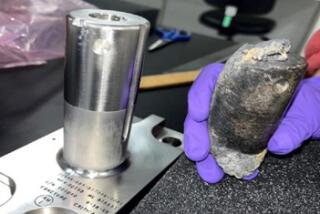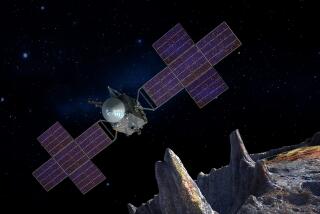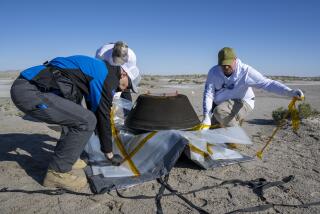Engineers propose blasting craft-threatening debris from orbit with an Earth-based laser.
The Boeing engineers giving space shuttle Atlantis its regular post-mission maintenance check have myriad routine tasks to perform, including, this time around, the unlikely job of replacing the windshield.
The reason? Think of it as interstellar road debris.
Outer space isn’t as rubble-strewn as Southern California’s freeways, but there’s enough trash out there that the shuttle windshields periodically need to be thrown out because of damage from multiple collisions with orbital debris.
This so-called space junk hurtles around the planet in low Earth orbit at a uniform speed of 30,000 feet per second, or 21,000 miles per hour. It ranges in size from flecks of paint loosened from satellite skins by oxidation to the remains of tanks blown apart by expanding remnants of fuel.
Ever since the Soviets launched Sputnik in 1957, the volume of space junk has been multiplying. And as the debris collides with other debris, the mass grows.
As it happens, the problem is with space junk that is neither too small nor too big. Space-faring vehicles can withstand run-ins with pieces of debris smaller than about a centimeter, or 0.4 inch, across. At the other end of the scale, fragments larger than about 4 inches, including spent rockets and retired satellites, are comparatively uncommon. They are also large enough to be carefully tracked by the North American Air Defense Command outside Colorado Springs, Colo., so satellites and shuttles can maneuver around them.
What concerns researchers is the 155,000 pieces of orbital debris that fall somewhere in between. To eradicate them, a number of aerospace scientists and engineers are proposing a futuristic solution: a laser that can shoot the junk out of the sky.
“With a modest-size laser and a modest investment, we can de-orbit essentially all of the dangerous pieces of debris from low Earth orbit space in three years,” says Ivan Bekey, who conducted a NASA study on the feasibility of such a laser before he retired from the space agency last year and opened his own consulting business. “All gone. Period.”
So far, orbital debris has created more of an operational nuisance than a major threat to space missions, although it is a constant factor in mission planning.
The position of larger chunks of debris is routinely taken into account in determining the timing of rocket launches so foreseeable collisions can be avoided--contingency time to allow floating obstacles to pass out of a mission’s trajectory is customarily built into launch countdowns. Similarly, the shuttle’s distinctive upside-down-and-backward position is designed partially to shield its most vulnerable surfaces from free-floating crud. The International Space Station being designed by the United States, Russia and several other countries will be outfitted with more than 200 types of debris shields to protect it against such encounters.
International efforts in the last few years to redesign satellites to shed fewer pieces have also kept the problem under control. But NASA is concerned enough that it operates a 40-person office at Johnson Space Center in Houston to track the orbiting garbage, complete with a supervisor whose formal title is program manager for orbital debris.
That individual is Nicholas Johnson, who notes, “We’ve never lost a spacecraft because of [debris], but it is impacting how we operate in space, in particular with manned space flight.”
That’s why interest in a junk-busting laser is building. The leading contender is a project called Orion, named after the mythical bowman enshrined in the northern sky as one of the best-recognized constellations.
The Orion proposal relies on a technique called ablation, which uses extreme heat to burn a small layer off the surface of an object and thereby change its momentum. A 25-kilowatt laser would shine one to five times a second for about a minute to bombard an object with hundreds of high-energy pulses. That’s enough to push most stray objects off a possible collision course with an important satellite or craft.
Following the principles of orbital physics, the wayward junk would be pushed farther from Earth before swinging back with a closer approach than before. Over a period of about 90 minutes, the orbit would continue to distort until the debris finally entered the atmosphere and incinerated from friction.
“It’s technically feasible,” says Claude Phipps, who first proposed the idea at Los Alamos National Laboratory in 1993 and now heads a Santa Fe consulting firm called Photonic Associates. “Nothing new has to be invented that we don’t already have.”
That’s not to say the project would be trivial. To reach space junk about 500 to 900 miles aloft, the laser would have to be between 10 and 20 feet in diameter and the cylinder focusing the beam as big as an optical telescope at an astronomical observatory.
A laser already being built at Lawrence Livermore National Laboratory for a nuclear fusion program would be suitable for the Orion project, and state-of-the-art optical sensors are precise enough today to meet Orion’s needs, says Bekey, who is now head of Bekey Designs, a space systems consulting firm in Annandale, Va.
Bekey’s NASA study pegged Orion’s cost at between $60 million and $80 million to shoot down the 30,000 pieces of space debris orbiting at distances of less than 500 miles above Earth. A more powerful laser to reach the additional 125,000 pieces circling between 500 and 930 miles up would raise the cost to between $150 million and $180 million, according to the study.
But Johnson, the NASA scientist who tracks orbital debris, estimates Orion’s true cost at closer to $500 million. That essentially prices it out of the realm of possibility for now (although many experts argue that the U.S. could enlist other nations to share the cost).
Many scientists question whether space debris will ever be a significant problem. They note that the orbital band in which even the most troublesome debris accumulates is vast, and that man-made debris amounts to a tiny fraction of the volume of micrometeorites and other naturally occurring detritus. Those factors, some argue, skew the cost-benefit calculation--especially given the high-priced options available today--sharply in favor of doing nothing.
“While cleaning up the environment is technically feasible today, it’s not economically viable with current or foreseeable near-term technology,” Johnson says. “Twenty or 25 years from now there may be lots of solutions that make sense. We need to keep thinking of new ideas.”
And not only technological ideas. The concept of blowing pieces of stray debris out of the sky raises a number of unprecedented legal and diplomatic issues.
“There’s a question as to whether any nation even has the right to unilaterally remove debris that belongs to another country,” says Roger Lenard, a program manager for space nuclear systems at Sandia National Laboratories in Albuquerque. “So much of space law has taken after maritime law, and no one has talked about laws of abandonment in space.”
And then there are diplomatic considerations.
“There’s some heavy political baggage involved any time you shoot a laser in the sky,” says Phipps, the former Los Alamos researcher. “People think you might hit an airplane, then people think about Star Wars and say the whole thing is potentially [politically] destabilizing.”
Several experts say that even if the Orion laser were to hit an operational satellite, it would not be powerful enough to do any damage or affect the craft’s orbit.
Although the Orion project is ambitious, it is not the most extravagant proposal for cleaning up the skies.
Sandia’s Lenard advocates a space-based laser system he calls a “debris sweeper.” A laser beam shot from orbit would not be subject to atmospheric distortions and would probably require less energy than a ground-based system.
The debris sweeper could probably fit inside a 15-by-15-by-30-foot module on the International Space Station, which would also make it accessible for repairs, Lenard says--but the cost would top $1 billion.
Another recurring proposal is to build an orbiting garbage truck that would retrieve big pieces of debris, such as spent rocket bodies. Some versions of this plan call for the vehicle to somehow consume the space junk and convert that mass into the energy it would need to move on to its next target.
“That technology is not feasible today at any price, but 20 years from now it might be possible,” Johnson says.
Perhaps the most bizarre suggestion is to launch what Johnson describes as a “giant Nerf ball” about a mile wide. As pieces of debris slam into it, they would slow down enough to fall into lower orbits and burn up in the atmosphere. (Among other drawbacks, the ball would need to be maneuverable so that it could get out of the way of operational satellites.)
Meanwhile, NASA and Air Force officials will be debating whether to give the green light to an Orion demonstration project that would cost between $5 million and $10 million, Bekey says.
“If we don’t infuriate the wrong people, it will get built, I hope in the next 10 years,” says Phipps.
“I hate to say this, but it’s going to take a big accident before the perception changes to where we really have to do this.”
(BEGIN TEXT OF INFOBOX / INFOGRAPHIC)
Junk Bombs
Hundreds of thousands of orbital debris fragments hover outside the Earth’s atmosphere. Traveling at speeds of 13,500 mph, these tiny chunks of one-time spacecraft can cause major damage to satellites and even the space shuttle. Orbiting vehicles can protect themselves against pieces of space junk smaller than 1 centimeter with special shields and other equipment, and they can maneuver out of the way of debris larger than 4 or 5 inches in diameter. But for the 150,000 pieces of space junk in between, some space scientists are proposing a radical solution: a ground-based laser that can literally shoot the debris out of the sky. Here’s how it would work:
1. Telescopes or radar systems locate individual pieces of debris to be de-orbited.
*
2. The laser shoots a low-powered beam to the piece of debris to track its position.
*
3. Engineers turn up the laser’s power to 25 kilowatts and send pulses to the debris fragment between one and five times each second, resulting in a few hundred pulses over the course of a minute.
*
4. The laser evaporates a few molecules from the fragment’s surface. The force of that reaction causes a slight change in its orbit, making the high point higher and the low point lower. Within about 90 minutes, the Earth’s atmosphere captures the debris chunk and burns it up.
The laser would be about as big as a telescope in an observatory, with a diameter of 10 to 20 feet. At 25 kilowatts, the laser would use about as much power as two homes. A NASA study concluded that such a laser could eliminate 30,000 pieces of space junk orbiting up to 500 miles above the Earth in three years at a cost of $60 million to $80 million. The 125,000 objects orbiting as high as 900 feet could be removed for an additional $90 million to $100 million.
Sources: NASA, Bekey Designs
More to Read
Sign up for Essential California
The most important California stories and recommendations in your inbox every morning.
You may occasionally receive promotional content from the Los Angeles Times.











